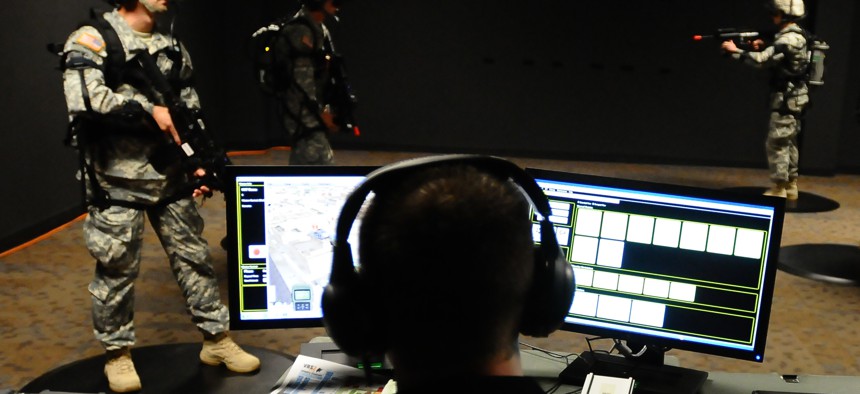
82nd Airborne Division paratroopers conduct a simulated mission Sgt. Joseph Guenther, U.S. Army (Public Domain)
How to Optimize Virtual Training for the Military
Virtual training holds significant promise for military readiness, but the Pentagon still lacks a comprehensive understanding of how to optimally balance live and virtual training. Developing a holistic taxonomy of training tasks is an important first step.
In a recent, landmark study of the military’s use of virtual training, GBC found that increasing the proportion of military training that incorporates virtual simulation could enhance readiness for a new era of defense while cutting costs.
But the study also highlighted the importance of developing a holistic taxonomy of training tasks that guides decisions about what types of tasks should be trained using virtual simulation. In the Fall of 2013, the Office of the Undersecretary of Defense for Personnel and Readiness quietly released a report entitled, “Optimizing the Mix Between Virtual and Live Military Training,” to establish a baseline for such a taxonomy. Using archetypal characteristics of training tasks, including their level of complexity and whether or not they require individual or collective action, the authors developed an algorithm to determine when it is feasible to use virtual simulation for specific training tasks.
Using this taxonomy, the report categorized a random, representative sample of 302 military training tasks from across the services based on whether or not they can be conducted entirely with virtual simulation. Tasks categorized are as diverse as mounting a night vision sight on an M16 rifle and processing commercial accounts transactions. In all, 60 percent of all tasks categorized are deemed appropriate for full virtual training - including 68 percent of individual tasks and 43 percent of collective tasks.
Noting the possibility to increase virtual training, GBC deployed a survey to 310 Department of Defense personnel to assess how much virtual simulation is currently being leveraged and how comfortable respondents would be with increasing its use. GBC used a simplified, four-pronged version of the OUSD report’s taxonomy to break down training tasks by type:
- Simple individual (e.g., operating a switchboard, discharging a firearm)
- Complex individual (e.g., flight training, language/cultural training)
- Simple collective (e.g., logistics support, managing manpower requirements)
- Complex collective (e.g., joint operation exercises, area reconnaissance)
The results revealed that military personnel are generally comfortable increasing virtual training as a proportion of all training, especially for simple tasks.
Current vs. Comfortable Level of Virtual Training
Moreover, both the current level and comfortable level of virtual training reported by respondents are lower than what the OUSD report deems possible . This is especially true for individual-type tasks. Whereas the GBC survey data shows that DoD personnel estimate that 38 percent of individual training tasks currently involve virtual simulation, the OUSD report reveals that 68 percent could be trained virtually. Importantly, because the OUSD report’s algorithm indicates only whether a given task can be trained entirely virtually or not at all, it is likely that there is even more room for growth for training that integrates some degree of virtual simulation (known as Live, Virtual, Constructive or blended training).
Current vs. Possible Level of Virtual Training
Both the initial taxonomy developed for OUSD and GBC’s complementary survey research are somewhat simplistic; they do not account for key external factors (e.g., cost), consider training tasks in the aggregate, and rely on respondent perception in the case of the survey. But they nevertheless demonstrate that the military can significantly increase its use of virtual training beyond current levels and set a valuable baseline for a more comprehensive taxonomy.
Click here for the full GBC report, “Going Virtual to Prepare for a New Era of Defense.”
Click here for the accompanying infographic, “The Promise of Virtual Training.”
This post is written by Government Business Council; it is not written by and does not necessarily reflect the views of Government Executive Media Group's editorial staff. For more information, see our advertising guidelines.